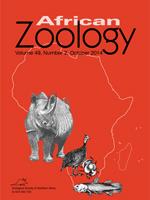All previous behavioural studies of Temminck's ground pangolins (Smutsia temminckii) have focused on populations in mesic regions. We examined home range size, activity periods, habitat selectivity and refuge site selection of 13 individuals over three years in the Kalahari Desert of South Africa, near the western edge of the species' range. Kernel home ranges of adults averaged 6.5 ± 5.9 km2, while juveniles had average home ranges of 6.1 ± 4.0 km2. Reliable prediction of 95% of the Kernel home range required 88 ± 67.7 tracking days. No significant habitat selectivity was observed. Earthen burrows were the most frequently used refuge type. The time at which activity commenced varied seasonally as well as among individuals, with an increase in diurnal activity during winter. Young pangolins also displayed more diurnal activity compared to adults. Individuals spent 5.7 ± 2.0 hours per 24-hour cycle outside of refuges, with no significant seasonal variation. Juvenile dispersal peaked during mid-summer, with individuals travelling up to 49 km from their natal areas. We estimate a breeding density of 0.16 individuals/km2 and a total density of 0.31 individuals/km2 for our study area. Our data suggest that activity patterns, movements and refuge selection is similar across the species’ southern African range, but that densities may be higher in the Kalahari compared to populations in more mesic eastern areas.
BioOne.org will be down briefly for maintenance on 12 February 2025 between 18:00-21:00 Pacific Time US. We apologize for any inconvenience.
How to translate text using browser tools
1 October 2014
Home Range, Habitat Selection and Activity Patterns of an Arid-Zone Population of Temminck's Ground Pangolins, Smutsia temminckii
Darren W. Pietersen,
Andrew E. McKechnie,
Raymond Jansen
ACCESS THE FULL ARTICLE

African Zoology
Vol. 49 • No. 2
October 2014
Vol. 49 • No. 2
October 2014
densities
habitat selection
home range
Manis temminckii
Smutsia temminckii




